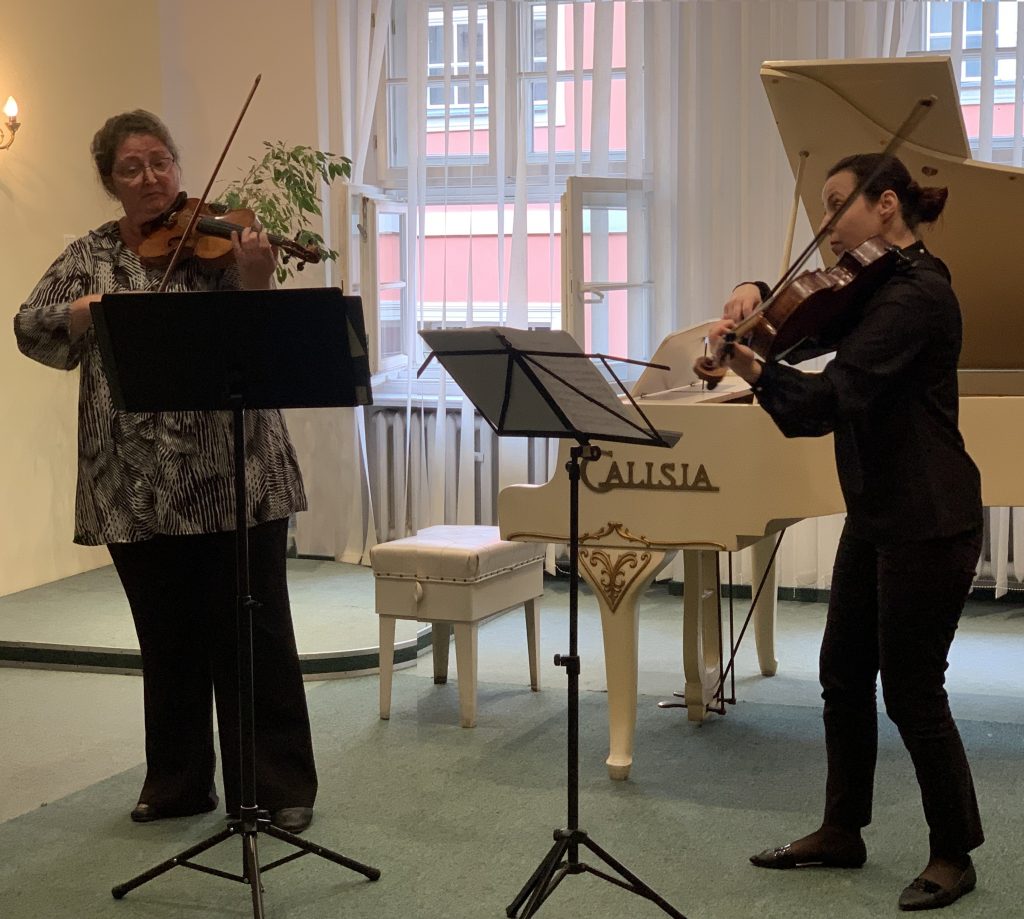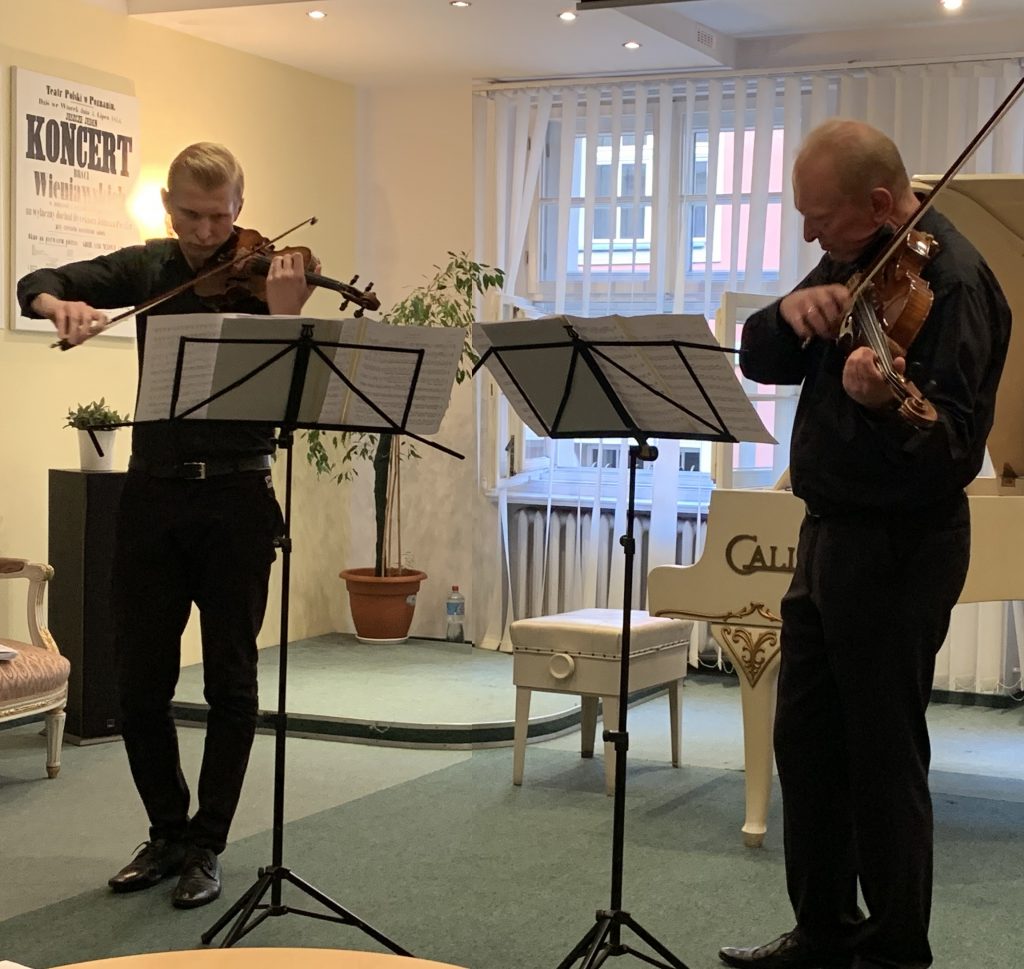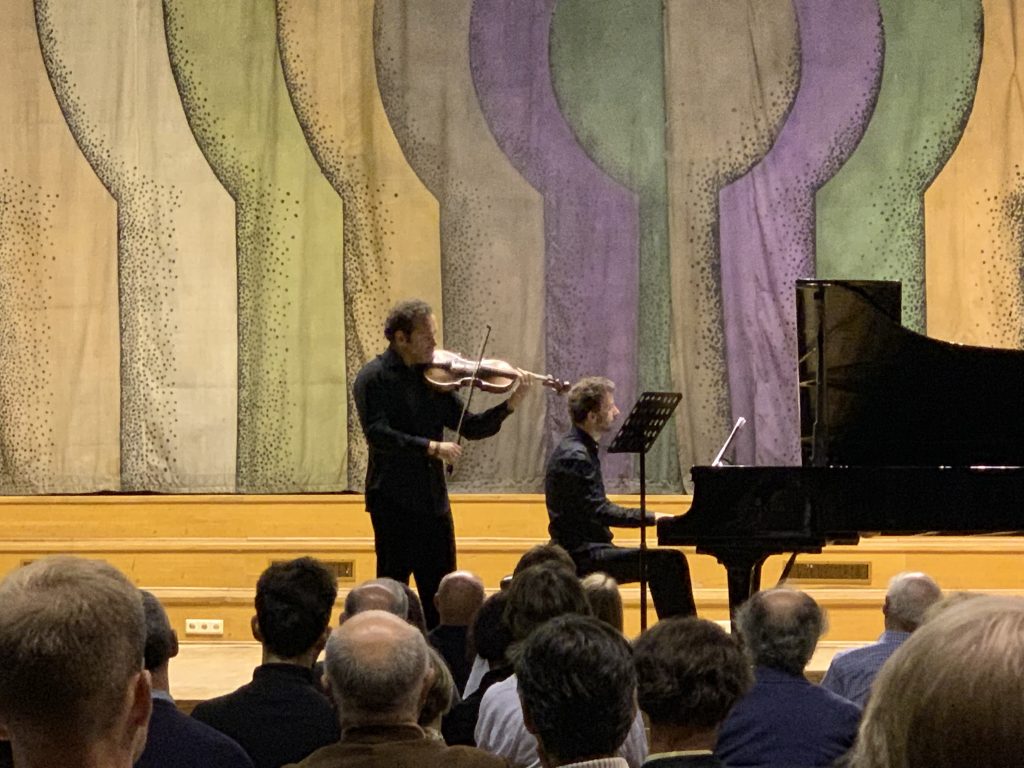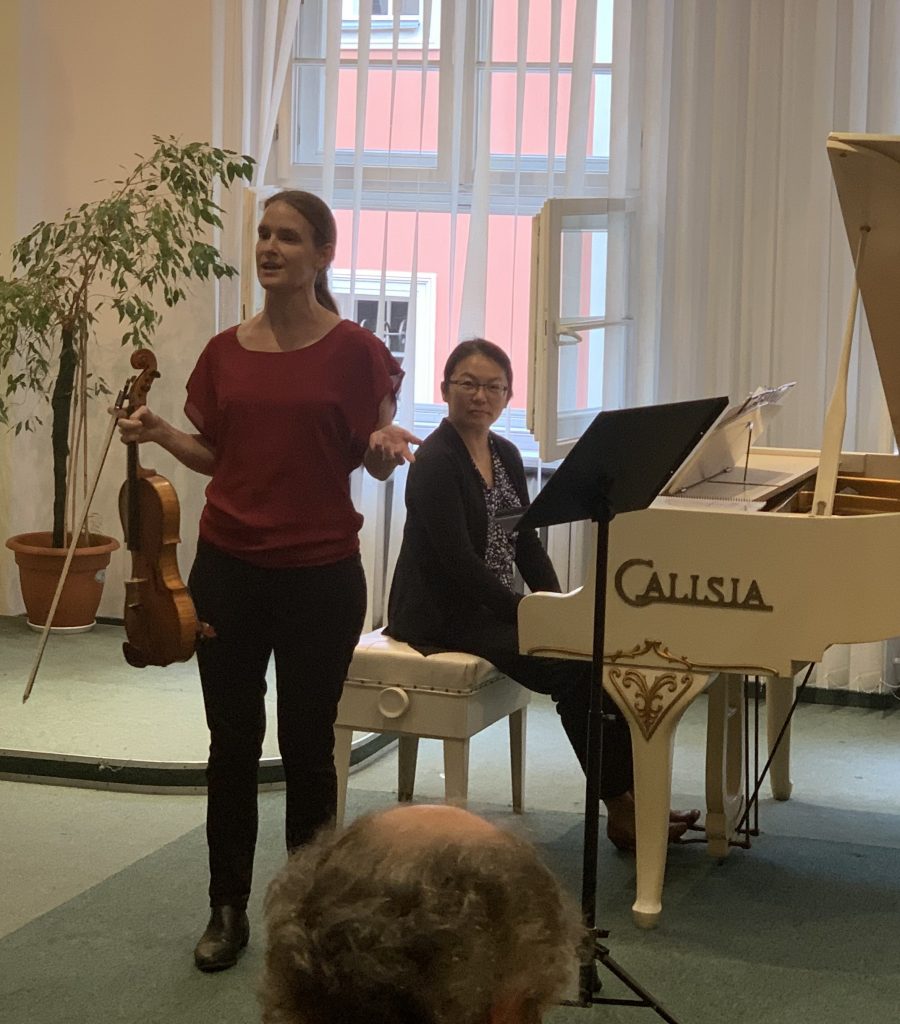The 46th International Viola Congress takes place in Poznan (Poland) from Sept. 24th – 28th, 2019. Your intrepid bloggers Karin Dolman and Kristofer Skaug bring fresh reports daily from this temporary hotspot of the viola universe.
Day 3: Thursday, September 26th, 2019
<previous day> <next day>
In spite of my “Eager” intentions, I did not make it to the morning lectures, let alone the 8am ensemble rehearsal. Karin and I went to the IVS Delegates’ Meeting, where the International Viola Society board shares information and feedback with the national section representatives. Without going into details, I was happy to see that there is a constructive dialogue in progress about the workings and directions of the IVS for the future.
The first presentation that I attended was a familiar one – DVS president Karin Dolman and her husband Jan van der Elst proudly presented the results of the Viola-building project during IVC2018 in Rotterdam. Jan gave a very good and entertaining presentation of the Luthier team and the building process, “how to build a viola from scratch in 5 days”. As work progressed towards increased integration of the instrument assembly, the opportunities to work in parallel decreased, until in the final stages it was essentially a one-man job. Working under such time pressure allowed no margin for error, and gave rise to heroic feats like carving the scroll in one day – a job that normally takes up to a week!
The viola was presented “in the white” (i.e. unvarnished) during the Closing Ceremony in Rotterdam, where the uncalibrated product was given test drives by Kim Kashkashian and Atar Arad. Today, 10 months later (almost to the day), the viola could be admired complete with varnish – which in many ways acts as a “sound equalizer”.
 Karin played a composition on the new viola, specially commissioned for this occasion by the Polish/Australian composer Paul Kopetz: “The Leprechaun” – complete with elfin ears and jingle bells around her ankles. It was an entertaining performance in and of itself, but more importantly it evidenced the great sound and playability of this instrument.
Karin played a composition on the new viola, specially commissioned for this occasion by the Polish/Australian composer Paul Kopetz: “The Leprechaun” – complete with elfin ears and jingle bells around her ankles. It was an entertaining performance in and of itself, but more importantly it evidenced the great sound and playability of this instrument.
There is more good news: The viola has been acquired by the Rotterdam-based Erasmus Foundation. Talented students can apply for a 2-year loan, during which they will be obliged to bring this “Erasmus Viola” to future IVC congresses, so that we can all enjoy this instrument as a kind of “international heritage”. More information about application procedures etc. will be posted here on the Dutch Viola Society website later.
 The rest of the presentations this afternoon took place in the Wieniawski house downtown, starting with a lecture by Carlos Maria Solare (IVS president) titled “The Emancipation of the Viola within the Romantic Orchestra“. Taking the classical viola “ripieno” role in 18th century music as a starting point, he illustrated with anecdotes and examples how the viola was entrusted new and more significant functions within the orchestra throughout the 19th century, including solo parts and dramatic underlining. Three composers were highlighted for their innovative use of the viola within the operatic literature in particular: Carl Maria von Weber (Der Freischütz, 1821), Hector Berlioz (La Damnation de Faust, 1846) and Richard Wagner (from Tannhäuser to Die Meistersinger von Nürnberg).
The rest of the presentations this afternoon took place in the Wieniawski house downtown, starting with a lecture by Carlos Maria Solare (IVS president) titled “The Emancipation of the Viola within the Romantic Orchestra“. Taking the classical viola “ripieno” role in 18th century music as a starting point, he illustrated with anecdotes and examples how the viola was entrusted new and more significant functions within the orchestra throughout the 19th century, including solo parts and dramatic underlining. Three composers were highlighted for their innovative use of the viola within the operatic literature in particular: Carl Maria von Weber (Der Freischütz, 1821), Hector Berlioz (La Damnation de Faust, 1846) and Richard Wagner (from Tannhäuser to Die Meistersinger von Nürnberg).
The lecture-recital “Recreating the 1919 Berkshire Music Festival Competition” by Hillary Herndon is the result of a project initiated by the American Viola Society last year towards a centennial commemoration of the 1919 Berkshire competition, which was entirely dedicated to viola sonatas. Previous to this composition contest, the viola literature only counted about 50 known sonatas; at the 1919 contest, 72 new compositions were submitted, more than doubling the available repertoire. It is known that the Rebecca Clarke and Ernest Bloch sonatas emerged tied in first place, but the other 70 non-winning entries were never identified. So this project attempts to identify viola sonatas that emerged around the 1919 time frame, and of which we may guess that they were submitted to the competition.
Accompanied by pianist Bernadette Lo, Hillary Herndon proceeded to play fragments from five unnamed pieces, and the audience got to vote which fragment they liked best. The winner turned out to be the 3rd movement (very much in the style of an Irish/Scottish jig) from Sir Granville Bantock’s viola sonata in F major. This work was subsequently played in its entirety (with some cuts – quote: “This music needed some pruning“, not only in order to fit into the available congress time slot…!). The artists received lots of well-deserved appreciation from the audience.
 The “afternoon recital” at 1700h consisted of a rich set of violin-viola duos. First, Annette-Barbara Vogel (Canada) and Raquel Bastos (Australia) skillfully performed the Six Bagatelles for Violin and Viola by Australian composer Margaret Sutherland (1897-1984). This is surprising music with lots of fun hairpin turns and spanning a wide spectrum of techniques, colours and moods. I hope to encounter it again in the future!
The “afternoon recital” at 1700h consisted of a rich set of violin-viola duos. First, Annette-Barbara Vogel (Canada) and Raquel Bastos (Australia) skillfully performed the Six Bagatelles for Violin and Viola by Australian composer Margaret Sutherland (1897-1984). This is surprising music with lots of fun hairpin turns and spanning a wide spectrum of techniques, colours and moods. I hope to encounter it again in the future!
Next came Lech Balaban with a solo Cadenza by Bogusław Schaeffer (1929-2019) – extracted from the same composer’s string quartet. It could be seen as a somewhat bipolar monologue, where each sentence is equipped with its own technical main feature: trills, fast runs of repeating figures, glissando, spiccato, pizzicato, tremolo, double stops and so on.
 After this, Balaban was rejoined by his son Jan on violin, to extend their set of violin-viola duos from the Tuesday evening concert. They first premiered a Scherzo by Marcin Molski, a 20-year-old composer who was present at this recital. The vibrant energy of this music was undeniably catchy. They proceeded to play the ultimate vioin/viola classic: the Passacaglia by Händel/Halvorsen. Both players articulated with exceptional control, so one could clearly hear “stereo bounce” effects that often get lost in the more gung-ho encore-style performances of this piece. But perhaps they took this a little too far, denying themselves the relief of a smile along the way – after all, it’s still supposed to be fun playing this, IMO! :-).
After this, Balaban was rejoined by his son Jan on violin, to extend their set of violin-viola duos from the Tuesday evening concert. They first premiered a Scherzo by Marcin Molski, a 20-year-old composer who was present at this recital. The vibrant energy of this music was undeniably catchy. They proceeded to play the ultimate vioin/viola classic: the Passacaglia by Händel/Halvorsen. Both players articulated with exceptional control, so one could clearly hear “stereo bounce” effects that often get lost in the more gung-ho encore-style performances of this piece. But perhaps they took this a little too far, denying themselves the relief of a smile along the way – after all, it’s still supposed to be fun playing this, IMO! :-).
The smiles surfaced nevertheless in the next piece, Arpeggio per viola by Alessandro Rolla. It has a furiously fast viola accompaniment, and with a very short length it seems designed as a show-off encore. I was left to wonder if this is an original Rolla, as the ending sounded quite unconventional (whence the smiles) …
Time to grab a quick pasta dish again before the Evening concert … however this time we were tempted to take dessert as well, which meant we arrived too late at the POSM Main Auditorium, where Polish violist Krzysztof Chorzelski had already started his recital with the (30-minute long) Schubert Arpeggione sonata.
The second piece tonight was Joseph Phibbs’ Letters from Warsaw, inspired by war-time letters that Chorzelski had found from his grandmother. The music starts calmly with an intimate sonorous song in the viola, increasing in intensity and then fading again. The next movement has a more agitated character, with tremolo-trills chasing some as-yet unseen target… the urgency increases and peaks with loud and dissonant chords. The third movement returns questioningly to the calm of the beginning, but the solace is temporary: The viola starts running frantically again, looking for some more permanent refuge. This cycle repeats itself, and then abruptly the running (and the movement) stops. The last movement rephrases the original song, after which the piano brings a soothing and serene lullaby. The viola echoes this lullaby with high harmonics, to end the piece. A beautiful and very personal performance by Chorzelski, with great control of tone. Compliments also to the pianist Lech Napierala!
 Andrzej Czajkowski (1935-1982) was a Polish pianist, composer, and a great all-round intellectual. His major work was a very ambitious opera based on Shakespeare’s The Merchant of Venice, which he completed shortly before his death. Through his friend Maciej Grzybowski, Chorzelski obtained the manuscript of Czajkowski’s viola sonata from the collection of Halina Janowska, who passed away very recently; so tonight’s performance was dedicated to her.
Andrzej Czajkowski (1935-1982) was a Polish pianist, composer, and a great all-round intellectual. His major work was a very ambitious opera based on Shakespeare’s The Merchant of Venice, which he completed shortly before his death. Through his friend Maciej Grzybowski, Chorzelski obtained the manuscript of Czajkowski’s viola sonata from the collection of Halina Janowska, who passed away very recently; so tonight’s performance was dedicated to her.
The opening theme is dominated by large intervals reminiscent of a despairing Prokofiev. Different moods and expressions alternate in dissimilar episodes. The 2nd movement has a dark an sinister piano introduction, the viola fluttering above this chasm. At one point there’s another Prokofiev-like allegro, but this soon morphs into more feverish kaleidoscopics. There’s a free cadenza in the viola that is interrupted by a stern choral in the piano, bringing the movement to a close. In fact, the whole piece feels to me like a long “dreamscape” full of seemingly incoherent images. So for the remainder of the performance, I cease my analytical attempts and surrender to just riding the wild waves of this music. It is an impressive and virtuosic performance by both players, appreciated by the assembled viola enthusiasts with an emphatic applause.
The Czajkowski sonata needs and deserves more listenings, it is enormously rich in material, and it is impossible – at least for me – to take it all aboard and immediately “connect the dots”. Given the composer’s reputation as an intellectual, its analysis would probably be a fruitful subject for a research paper.
Editor’s postscript: We have learned that a dedicated web page exists for the Czajkowski viola sonata, maintained by mr. David Ferré – check it out here.
We stay on for Viacheslav Dinerchtein‘s late-night Magic show with “no strings attached” (52 cards and no viola!). With great humour and subtle misdirections (at least I’ll stick to that as explanation for sanity’s sake), Slava led us through a series of perplexing card-guessing games. The Poznan IVC Office’s always-friendly front-desk manager Edyta Butor (I promised her a beer when all this is over!) and IVS president Solare willingly acted as tableside victims of Dinerchtein’s playful deceptions. A much-appreciated non-viola-related wind-down activity after the 3rd full day of viola congress!
– Kristofer
<next day>


